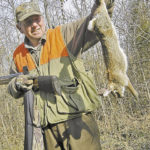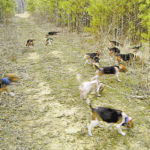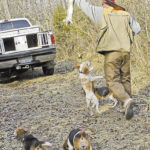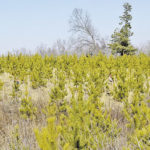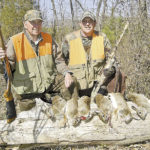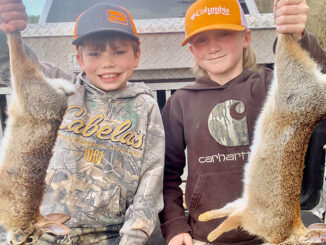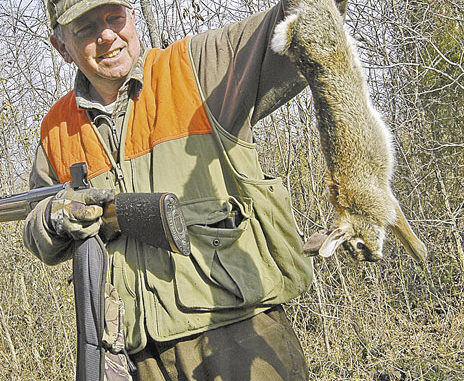
Hunting bunnies with beagles not only is a Southern tradition, but it keeps hunters in shape and provides tasty meals.
The beagles’ tails appeared to be wagging fingers, a wave of vertical, white-tipped periscopes, eight to 10 inches long, moving purposefully through the green and gray of a frost-covered January morning.
The appendages above the dogs’ backs were the only indicators the pack was on the prowl for a rabbit. None of the little dogs uttered a sound.
“It’s what you want them to do — have a tight mouth,” said Charles “Art” Thompson of Snow Camp, 63 years old but still as athletic-looking as when he was a first-team all-conference football quarterback, basketball forward, and baseball pitcher at Alexander Wilson High School during the mid-1950s. “You don’t want them to open up until they smell a rabbit.”
The descendant of three generations of Alamance County farmer-hunters, Thompson knows cottontails — and swamp rabbits — are as crafty as whitetail deer when it comes to eluding 2- and 4-legged pursuers.
If a farm-bred rabbit hears the sounds of beagles moving toward him, it often will skulk away in another direction, perhaps toward a hole in the ground or a fallen tree spanning a stream — just like a wise old buck deer leaving the country at the sound of loud talking or car doors slamming in his home territory.
At other times a rabbit, believing the dogs are too close to its hiding place, will sit quietly, backed into a weedy “bed” or crouch underneath a brushpile and hope the hounds will pass by. He is “keeping his cool,” as ’60s hippies used to say.
The bunny’s hope is to not draw the attention of the pack because a rash action, such as running blindly in fear, puts out fresh scent. Then the dogs will lock their attention on him like heat-seeking missiles tracking the exhaust of an enemy jet. The tactic works sometimes, especially if other rabbits in the neighborhood have been hopping about, foraging on grasses, meeting girlfriends or gnawing the bark of small trees.
Many times, a “strike” dog will hit a rabbit’s trail, bark a few times to let everyone know “Hey, there’s been one here!” It’s often a single “ba-hoooop!” bark. But that rabbit’s scent trail may cross another track, and the pack may become diverted. Meanwhile, the original bunny will put distance between himself and his pursuers while they try to figure out the scent puzzle on the ground.
That’s when a beagle pack needs a good “swing” dog that will cast back and forth, trying to pick up a rabbit’s trail. A good pack of beagles usually has one top-notch swing dog.
But there’s no confusion for beagles when a rabbit decides to run and expends energy — that’s when it leaves on a “hot” trail. That makes sense (and scent) because a running rabbit’s trail apparently smells differently to beagles than a cold one. The dogs know there’s a live, scared-out-its-wits cottontail or bluetail (i.e., swamp rabbit) at the end of a smokin’ scent path.
And off they’ll go, roaring in unison, determined to run down their fleeing target.
Of course, that’s when hunters must do their part, listening and positioning themselves to intercept the fleeing bunny. Hopefully for the hunters, the chase will end in a shotgun’s boom and a rabbit stuffed in a hunting jacket for later use in the kitchen.
“It’s music to my ears,” said Wallace “Wally” Jones, the 69-year-old landowner who allowed Thompson and his son, Chris Thompson, Mark Prather, Mike Bivins, Greg Greeson, Danny Smith and Jody Andrews to drive their pickups to his land and release several dog boxes full of beagles one Saturday morning last January.
Jones’ property is a mixture of hardwood patches, logging roads and cleared woods replanted in pines: classic, upper Piedmont farm land. Creek bottoms between woods and fields are thick with undergrowth as are cutovers in different stages of regrowth — perfect rabbit habitat.
“I’ve enjoyed listening to good rabbit races all my life,” Jones said, “but there’s not much I can do in the way of walking to keep up. I still like fried rabbit though.”
Jones monitored the hunt by riding his ATV along woods trails, stopping to listen to the sweet chorus of the pack in full cry.
Before Jones’ arrival, the hunters had stood in an old logging road and listened intently. They only heard leaves rustling, brush pushed aside and snorts huffed from wet nostrils as a veritable tornado of black, tan and white legs, feet and tails swept across the road and disappeared into a thick cutover.
“Baa-oop!” a lone beagle cried, somewhere in a stand of young pines infested with briars and honeysuckle.
“That dog’s got the scent,” Thompson said.
A few seconds passed and another beagle “booped” as it also got a hint of a cottontail that had sneaked away through the cutover after hearing the rustle of the pack snuffing its way toward its hiding place.
In a minute, the entire chorus joined in, and the “race” began in earnest. Anxious but joyous yelps filled the air.
The hunters scattered in different directions, some following the dogs, others heading for cut-off spots where they thought the rabbit might run.
“You’d never kill a rabbit if most of them ran like deer,” Thompson said. “Mostly they run in a circle and come back to the same place where the dogs jumped them.”
The trick for a hunter is to figure out which way the trail of a pursued rabbit will loop, then try to get into position where he can see the bunny zipping along in front of the dogs in order to sent a load of No. 6 pellets in its direction.
“You can’t concentrate (look) right in front of the dogs,” Thompson said. “Sometimes a rabbit will be 50 or 75 yards in front of the dogs. And (rabbits) are running close to the ground, so you got to forget everything you learned about deer hunting and not look too high. You gotta look on the ground to see a rabbit.”
Snap shots in thickets are common, similar to the instinctive discharges that wing-shooters take at bobwhite quail that explode underneath their feet.
The Thompsons carried 12-gauge auto-loaders holding No. 4 and No. 6 shotshells, although many rabbit hunters prefer smaller gauges, such as 16s or 20s. Some hunters even use .410-gauge shotguns.
Everyone wears blaze orange vests or caps for safety’s sake.
“I like a 12-gauge for rabbit hunting because you get shots in thick stuff, and it seems like you got a better chance of getting a bigger pellet through and into a rabbit,” Thompson said. “I also like to be able to get off more than one shot if I need to.”
Thompson and his hunting partners are competitive when it comes to bagging bunnies, even decades after leaving behind organized athletics. Art was a high draft pick of the Chicago Cubs, reaching the AAA level before returning home to eventually take a job in the Research Triangle.
His son, Chris, was an all-conference baseball pitcher who starred on Southern Alamance High School’s 3-A state championship team in 1987. He played on the varsity basketball team as well and now coaches his sons.
Many of the other hunters also played high school athletics, so it means something that the hunter who takes the most rabbits gets bragging rights for the day.
“We keep a count of how many rabbits we kill each year,” the elder Thompson said. “Right now, we’re at about 95. We’re all deer hunters, but when deer season goes out, we rabbit hunt.”
They also hunt for another reason — it keeps them in good physical condition.
“It’s good exercise,” Thompson said. “You hunt rabbits all day, and that means you’ve walked several miles. It’ll get you in shape and keep you in shape.”
Most the places they go require physical stamina to follow the dogs and get in position to intercept rabbits.
“If you’re going to keep up with the dogs, you have got to go through some pretty tough territory,” he said.
Brush-buster jackets and pants are a necessity, as is comfortable but waterproof footwear.
The reward for their effort. Listening to the dogs work is certain a big part, but not the only one.
“All of us like to eat rabbit, too,” Thompson said. “We grew up on it.”

